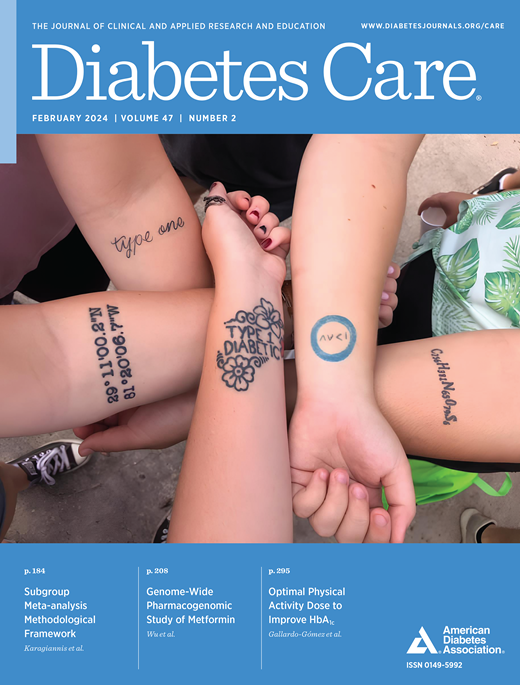低剂量胰高血糖素预防和治疗1型糖尿病患者运动相关性低血糖:一项系统综述和荟萃分析
IF 16.6
1区 医学
Q1 ENDOCRINOLOGY & METABOLISM
引用次数: 0
摘要
1型糖尿病(T1D)患者由于低血糖风险而难以控制运动。研究设计和方法本系统综述和荟萃分析评价了低剂量胰高血糖素预防和治疗T1D运动性低血糖的疗效。Medline、Embase和Cochrane CENTRAL检索了截至2024年9月的随机对照试验和交叉研究。该分析包括接受低剂量胰高血糖素与非胰高血糖素治疗的T1D青少年和成人。胰高血糖素样肽、非胰岛素组合或不受控制的运动设置的研究被排除在外。两位作者提取了这些数据。采用偏倚风险-2工具和建议分级评估、发展和评估框架对方法学质量进行评估。偏倚风险为2,进行敏感性分析。meta分析采用随机效应模型估计低血糖和低于范围时间(TBR)(葡萄糖&;lt;3.9 mmol/L)的综合治疗效果,以及次要结局和不良反应。结果在6792份记录中,12项研究涉及248名个体(平均年龄:36±10.5岁)符合纳入标准。荟萃分析显示,低剂量胰高血糖素显著降低了低血糖风险(风险比0.54;95% CI 0.35, 0.84)和TBR(- 3.91个百分点;95% CI - 6.27, 1.54)。敏感性分析对低血糖和TBR产生了更有信心的效应值。然而,低剂量胰高血糖素组总体不良事件增加(风险比2.75;95% CI 1.07, 7.08)。纳入的研究较少且异质性,这可能影响了总体结果。结论:低剂量胰高血糖素可降低T1D患者运动性低血糖和TBR。未来的研究应该优化各种运动类型和持续时间的胰高血糖素剂量和时间,以确认实际效果。本文章由计算机程序翻译,如有差异,请以英文原文为准。
Low-Dose Glucagon to Prevent and Treat Exercise-Associated Hypoglycemia in Individuals With Type 1 Diabetes: A Systematic Review and Meta-analysis
OBJECTIVE People with type 1 diabetes (T1D) struggle to manage exercise because of hypoglycemia risk. RESEARCH DESIGN AND METHODS This systematic review and meta-analysis evaluated low-dose glucagon's efficacy for preventing and treating exercise-induced hypoglycemia in T1D. Medline, Embase, and Cochrane CENTRAL were searched for randomized controlled trials and crossover studies until September 2024. The analysis included T1D adolescents and adults treated with low-dose glucagon versus nonglucagon treatments. Studies with glucagon-like peptides, noninsulin combinations, or uncontrolled exercise settings were excluded. Two authors extracted the data. The methodological quality was assessed with the Risk of Bias-2 tool and Grading of Recommendations Assessment, Development and Evaluations framework. Risk of Bias 2 informed a sensitivity analysis. The meta-analysis employed a random effects model to estimate the pooled treatment effects on hypoglycemia and time below range (TBR) (glucose <3.9 mmol/L), as well as secondary outcomes and adverse effects. RESULTS Of 6,792 records, 12 studies involving 248 individuals (mean age: 36 ± 10.5 years) met inclusion criteria. The meta-analysis showed significant reductions in hypoglycemia risk (risk ratio 0.54; 95% CI 0.35, 0.84) and TBR (−3.91 percentage points; 95% CI −6.27, 1.54) with low-dose glucagon. Sensitivity analysis yielded a slightly more confident effect size for hypoglycemia and TBR. However, overall adverse events increased with low-dose glucagon (risk ratio 2.75; 95% CI 1.07, 7.08). The included studies were few and heterogeneous, which may have influenced the overall outcomes. CONCLUSIONS Low-dose glucagon reduces exercise-induced hypoglycemia and TBR in T1D individuals. Future research should optimize glucagon dosage and timing for various exercise types and durations to confirm real-world effectiveness.
求助全文
通过发布文献求助,成功后即可免费获取论文全文。
去求助
来源期刊

Diabetes Care
医学-内分泌学与代谢
CiteScore
27.80
自引率
4.90%
发文量
449
审稿时长
1 months
期刊介绍:
The journal's overarching mission can be captured by the simple word "Care," reflecting its commitment to enhancing patient well-being. Diabetes Care aims to support better patient care by addressing the comprehensive needs of healthcare professionals dedicated to managing diabetes.
Diabetes Care serves as a valuable resource for healthcare practitioners, aiming to advance knowledge, foster research, and improve diabetes management. The journal publishes original research across various categories, including Clinical Care, Education, Nutrition, Psychosocial Research, Epidemiology, Health Services Research, Emerging Treatments and Technologies, Pathophysiology, Complications, and Cardiovascular and Metabolic Risk. Additionally, Diabetes Care features ADA statements, consensus reports, review articles, letters to the editor, and health/medical news, appealing to a diverse audience of physicians, researchers, psychologists, educators, and other healthcare professionals.
 求助内容:
求助内容: 应助结果提醒方式:
应助结果提醒方式:


